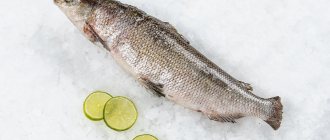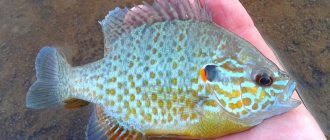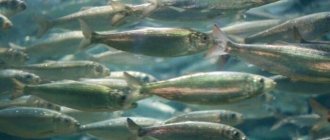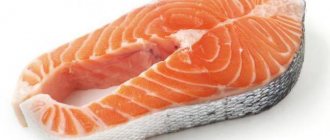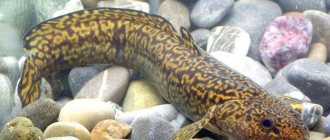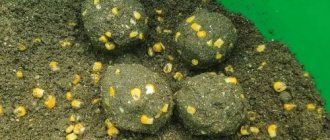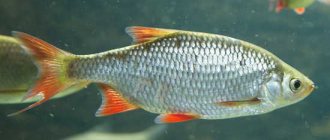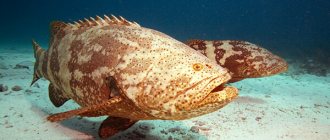Who is she and where does she live?
Who is she, Marinka fish? What kind of fish is it, what does it look like and where does it live? The nimble and dexterous marinka, although it belongs to the carp, received the nickname “trout sister” for its willful disposition and behavioral characteristics.
She lives in Central and Central Asia and Kazakhstan. In these places it is also often called “karabalyk”, which translates as black fish. Very rarely, it can be found in Ukraine and the European part of Russia. Marinka lives in almost any conditions, but is most often found in mountain rivers and lakes. It can also be found in springs among cliffs, lowland rivers, rifts and cold streams. In most of Asia, this fish fills all existing reservoirs, is considered a weed and is not particularly loved by professional fishermen.
Features of behavior
Marinka prefers to settle in fast rivers with cold water and pebble-sandy soil. This fish is practically never found in well-warmed stagnant lakes.
She usually stands at the very end of the roll, hiding behind boulders. When a food object appears in the stream, the marinka quickly leaves the shelter, grabs the prey and returns back.
Interesting! In slow-flowing rivers, the behavior of this fish resembles the traditional way of life of most representatives of the carp family.
It digs through bottom sediments in search of bloodworms and other invertebrates or scrapes filamentous algae from stones, as does its closest relative, the roach.
In the third year of life, Marinka begins to show her predatory tendencies. By this age, it already has a length of about 15–25 cm (depending on the species). Her diet begins to include:
- tadpoles;
- fry of other species;
- lizards;
- little frogs.
Adults often hunt for mice crossing the river. For the winter, the fish migrate to the lower reaches, where there are usually deep holes. Throughout the entire freeze-up period, it does not show feeding activity.
Features of Marinka
This nimble fish prefers clean, flowing water, so most often it can be seen on small rapids and waterfalls; it overcomes them with ease. Local residents have found an original way to use marinka for their own purposes. This omnivorous fish is used to clean wells - it quickly and happily destroys all kinds of crustaceans, leeches and various vegetation there. Fish is also widely used as food.
This is where its main feature lies. The fact is that Marinka fish is poisonous. More precisely, not all fish are poisonous, but only the gills, caviar and the black film lining the inner surface of the belly. To avoid poisoning, you need to carefully remove these parts before cooking. Despite the fact that Marinka fish is poisonous (photo below), its meat is very tasty, tender and quite fatty, so learning how to properly cook this fish is a truly worthwhile endeavor.

Why is it dangerous?
Although Marinka is poisonous, it does not cause much harm - it can poison a person with its poison only when consumed. She is also capable of spreading it in water. The most dangerous time is spawning. Then the concentration of hazardous substances increases. The poisonous parts are usually removed, as is the black membrane inside the abdomen. It is recommended not to leave all removed parts at home, but to immediately destroy them. Caviar becomes poisonous only at the stage of large egg growth. It is toxic to most mammals, humans and birds.
Toxicity is an adaptive feature of life in foothill areas, where fish are attacked by animals. They do not eat the eggs of this fish, thereby not reducing the population. Fish must be thoroughly processed before consumption. In case of poisoning, you must consult a doctor; death is possible.
Appearance and structure
The Marinka fish has an elongated, elongated body, covered with small dense scales, which become somewhat larger near the caudal fin. The back of the fish is gray or gray-green, and towards the lower part the shade gradually darkens on the sides, turning into black. This is a classic option, however, depending on the habitat, the color of the marinka may change. Quite often, for example, you can find pale yellow or orange fish with a greenish head. Above Marinka’s upper lip there are short but quite noticeable mustaches - there are two pairs of them, a larger one and a smaller one.
Most often, individuals are found measuring about 25–30 cm, but much larger specimens are also found. The largest ones can weigh several kilograms.
Marinka structure
The appearance of an inhabitant of fast currents immediately reveals that he is a strong, swift swimmer with an excellently developed sense of smell and a bottom-based type of feeding. Distinctive features of the marina fish's exterior include:
- muscular, elongated body of slightly oval cross-section;
- a strong sloping back of gray, dark brown or chestnut color (the color is influenced by the habitat);
- large olive green head;
- well developed two pairs of whiskers;
- downward-facing mouth with fleshy lips and a lunate lower jaw;
- pale silver, creamy yellow, bronze or grass-ash color of the sides;
- light belly;
- dense small scales covered with thick mucus;
- elongated caudal peduncle;
- orange iris;
- high triangular fin with a spine.
Marinka fish belongs to the class of six-rayed subfamily of split-bellied fish (Schizothoracinae), therefore it has a unique physiological feature (“split”), which is a fringing of large scales (15-29 pieces) around the anus.
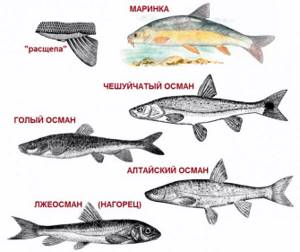
The closest relatives of the genus (Schizothorax) are the Ottomans (Diptychus) or the pseudo-Ottomans (Schizopygopsis). The latter, due to their strong attachment to high-mountain rivers, received an additional official name - the Highlanders.
In turn, the popular nicknames of Marinka are associated with tender milky meat, silvery sides, a light belly - “akbalyk” (white) and a dark film covering the inner surface of the peritoneum - “karabalyk” (black) fish. In addition, the species has another common name - “sharmai” (from Kazakh “ball” - round, “may” - oil), which appeared due to its torpedo-shaped body and thick slippery mucus on the scales, facilitating rapid movement in rapids.
To learn more:
White carp: description of the fish and methods of catching it
Kinds
In total, there are 4 varieties of Marinka fish, each of them differs not only in its habitat, but also in its dietary preferences.
- Marinka common. The size of this fish can reach 70–80 cm, and its weight varies from 300 grams to several kilograms. The common marinka is very omnivorous - it can feed on both algae and fry of its own species. This is the most common type of marinka, which is found throughout almost the entire territory of Central Asia.
- Pike-shaped marinka. In size and appearance, it is practically no different from the previous species, however, it prefers to eat animal food - fry, crustaceans, water bugs, and so on. It lives more often in water bodies of Turkmenistan.
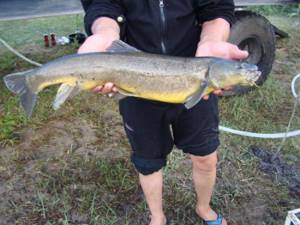
- Balkhash Marinka. From the name it is clear that it is found mainly in the slightly brackish waters of Balkhash, as well as in other reservoirs of Turkmenistan. Unlike previous species, the Balkhash marinka is not so large, its dimensions rarely exceed 35–40 cm. It has quite large scales, but its mouth and mustache, on the contrary, are relatively small. Since its main food is vegetation, its meat is not as tasty as compared to its carnivorous counterparts.
- Ilyinskaya Marinka. This variety is the largest, some individuals can reach 1 meter in length. The weight of the largest individuals of the Ilyinsky marinka can fluctuate between 11–12 kg. Its distinctive feature is its rather large, luridly disproportionate head. This fish is exclusively predatory and lives, for example, in the Ili River, as well as in the Kapchagai Reservoir. Due to its former popularity, the Ilyinskaya marinka is listed in the Red Book; the last catch of this fish was recorded in the late 70s of the last century. Today they are trying to breed it artificially.
This is what Marinka fish is like. Where is this freshwater beauty found and how can you catch it? Go ahead.
Fishing for marinka
Marinka is a sensitive, timid, and cautious fish. When she hears footsteps or sees a fisherman on the shore, she immediately disappears. Therefore, when fishing for it even in muddy water, great care is required. When approaching the fishing spot, you need to step quietly, trying not to rattle the coastal pebbles. When fishing in reservoirs with light water, you also have to camouflage yourself: approach the reservoir either from behind the bushes, or so that the angler’s shadow does not fall on the water.
In large bodies of water, marinka is caught with a donka and spinning rod:
- on the lure
- on a dead fish or frog mounted on a tackle.
In rivers or streams they fish with a wire, and in small streams they use a long fishing rod without a float, with a ball sinker. Worms, pieces of marinka itself, grasshoppers, and also plant baits are used as bait. You need to cast onto riffles, into whirlpools and whirlpools, and behind boulders. In a small marinka, the bite is similar to a double push, while a large one immediately bends the rod.
In Lake Issyk-Kul, marinka is caught not only in summer, but also in winter - using spoons or live bait.
The Balkhash marinka is caught in the spring with a worm; at this time it is caught by chance on a plant bait.
They catch marinka with a regular and bottom fishing rod, as well as with a spinning rod. An ordinary fishing rod is convenient in mountain rivers, streams, whirlpools and riffles. A thin rod should have a length of 5-7 m, a strong line should be 0.2-0.4 mm thick. The longer the rod, the better, as it will allow you to fish without going close to the shore and without fear of spooking sensitive fish. The fishing rod is not equipped with a float; you need a heavy sinker that delivers the bait to the bottom. In this case, the bite is transmitted through the line and the rod to the angler’s hand, in addition, it is visible from the deflection of the top of the rod. Naturally, the thinner the rod tip, the more noticeable the bite.
The size of the hook depends on the size of the fish you are going to catch, and can be from No. 4 to No. 8. A sliding sinker is preferable. Its weight depends on the speed of the river. You need to install the sinker so that it stops approximately 35-40 cm from the hook.
Considering the possibility of snags, you should take with you spare leads and sinkers, as well as a release.
On hot days, marinka feeds mainly at night, and they try to catch it in the early morning or late evening. If the water becomes cloudy after rain, the marinka rushes to the mouths of light streams. Usually in a small river it is located like this: in the lower reaches, where it is deeper, there are large specimens, and in the upper reaches, where it is shallow, there are small ones. But sometimes this rule is violated - large marinkas rise to where the shallows are, apparently in search of food.
You cannot catch marinka while sitting on the shore. You should walk along the bank of the river (stream) and cast into holes, whirlpools, whirlpools, rifts, and generally into all those places where fish can be found. If there are no bites, you need to bait the bottom 3-4 times and then move on. There is no need to neglect even small whirlpools. Often a large marinka stands in such small and narrow places that, when you pull it out, you wonder how it fit there. On riffles, it is recommended to throw the bait above the riffle so that it is carried away by the current. This is where the marinka, “on duty” below the riffle in the whirlpool, can grab it.
The bite of the marinka is sharp, transmitted along the rod to the hand by a double blow, and in large fish - by the bend of the rod. Once you feel a bite, you should not hesitate to hook - it should be energetic and sharp. A strong fish, once hooked, immediately rushes downstream, trying to get behind the rocks and break the tackle. While playing, she resists very energetically and persistently. Therefore, the fisherman must energetically and persistently, but carefully and patiently fish for the marinka, not allowing it to go into the stones.
Fishing for marinka with a bottom rod
They fish with a bottom fishing rod in large bodies of water, as well as in wide and deep areas of mountain rivers. Since the current is strong, it is necessary to place the load so that it is not carried away by the water, and the line does not lie parallel to the shore. In addition, when a light load is carried away by the current, it will quickly fall under the stones and break off. But too much weight is not good, as it will hide the bite. On each river, at each place, the weight of the load has to be determined experimentally. Therefore, when going fishing for marinka in an unfamiliar body of water or an unfamiliar place, you should take with you a set of sinkers of various weights.
It is convenient to use a bell as a bite indicator. You can’t move far from the bottom fishing rod so as not to miss the bite and hook it in time. Marinka is a fast fish, and if you delay hooking, she will take the bait and leave.
With a spinning rod, just like with a bottom fishing rod, you can fish in wide and deep reservoirs, in pools below rifts, as well as in quiet reaches between rifts. The best bait is a small fish, a local breed on the tackle, and if it is not available, a small bait like “Baikal” or “Universal”, similar in color and shape to the small fish found in a given body of water. Scaffolding - no thicker than 0.45 mm. The bait should be cast across the river and held at the very bottom at the lowest speed, remembering that the Marinka is a bottom-dwelling fish.
You can catch marinka all spring, summer and autumn, with the exception of spawning time. Due to the fact that marinka mainly feeds at night, it should be caught at night with bottom fishing rods. You can fish in muddy water during the day. It is best to fish in mountain rivers, streams and reservoirs with light water in the evening and early morning. During the day, you need to look for marinka in places shaded by trees and the shore. As a rule, large marinka are caught at night, and small ones are caught during the day.
Marinka is very picky about bait, and if you don’t know the reservoir, it’s best to ask local fishermen what she’s biting on at the moment. In general, bait for marinka can be very diverse. When the spring waters recede, it bites well on earthworms and red dung worms, in the summer - on dung worms, fry, cut fish meat, grasshoppers, crickets, flies, horseflies. Crickets can be found in late summer and autumn in fields under clods of earth and under various debris. In the fall, when the berries ripen, Marinka takes sea buckthorn and mulberry berries (in the places where these trees grow). There are cases when Marinka came across unusual baits for her - bread, meat, sausage. The best baits should be considered for small marinkas - inhabitants of the bottom of a given reservoir, and for large ones, in addition, small fish.
Where to catch marinka
Since this fish often prefers a predatory method of feeding, it lives where it is most convenient for it to hunt.
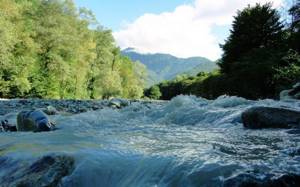
In winter, it can be found in the estuarine areas of rivers - the depth there is sufficient, and the current is not so fast. In fast mountain rivers at this time of year, the marinka tends to go closer to the bottom; the deep currents are not so strong. She also loves to hide in the quiet backwaters of lakes.
In the summer, Marinka goes to the rapids. There, among piles of stones, in the lower reaches of rivers, she waits for her prey. The predator also likes to sit in gullies, between bushes and stones - also an excellent place for hunting.
To catch this cunning predator, the fisherman will have to observe the strictest silence and cast the gear very carefully.
Where to catch marinka
Cautious fish tries to stick to the river or lake bottom at depths of 1-5 meters. The main criterion for comfort is moderate or strong coolness of the water and the presence of secluded and nourishing places:
- dense coastal thickets;
- flooded bushes;
- estuary areas with reverse flow;
- tall aquatic vegetation;
- slopes, edges;
- a pile of stones;
- channel bends;
- holes, rifts, whirlpools;
- coastal ravines, gullies;
- structures and supports in water;
- overhanging branches.
To learn more:
Description of bluefish fish: habitats and fishing methods
When choosing a place to catch marinka in Kazakhstan, Uzbekistan or another Central Asian country, you should avoid areas of a river or lake with a very strong current, silted bottom, completely stagnant or well-warmed water.

Tackle for Marinka fish
To catch this fish, they most often use a fishing rod with a float, a spinning rod with a reel and guide rings, a casting rod or a donkey - it doesn’t really matter.
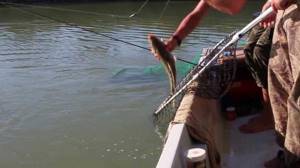
But what really matters is the length of the rod. Since the Marinka fish is very shy, cautious and can see a person standing on the shore very well, you need to choose a rod with a length of at least 7 meters.
You can take a fishing line that is not too thick, about 0.4–0.5 mm, and attach a pair of No. 5 hooks to it, while leaving long, up to 30 cm, leashes. You also need to choose the right sinker; its weight depends on the depth of the reservoir and the speed of the current. For control, you can use blue or red electrical tape, wrapping it around the fishing line. This will not frighten the fish, but, on the contrary, will interest it - after all, Marinka is used to eating butterflies that have fallen into the water.
Body structure
The body is elongated, oval in shape. Covered with small scales. Near the caudal fin, the scales become larger. In the corners of the upper part of the mouth there are 4 small antennae. The pharyngeal teeth are three-rowed.
Above the body is light, cream or gray. The lower part of the body darkens. The belly is black. Color may vary depending on habitat. Individuals can be light yellow or orange. The head is greenish.
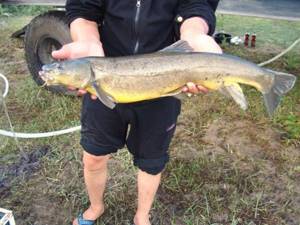
Most often, the length varies from 20 cm to 25 cm. Sometimes, however, larger individuals are found, whose body reaches half a meter. The mass of large individuals reaches several kilograms.
What to fish with
As already mentioned, the Marinka fish is quite omnivorous, so the bait for it will depend on the time of year.
In the spring, a variety of bugs, worms and moths are perfect. If you want the bite to be better, look for bait on the shore of the reservoir where you are going to fish - the fish are used to it and it will be easier to deceive it. You can find representatives of the local fauna under stones, in depressions and in coastal bushes and grass.
In summer, Marinka fishes best on various berries: cherries, grapes, mulberries. However, she also does not disdain dough and worm beetles.
By autumn, with the arrival of cold weather, predator fish require more and more meat food. Therefore, she will say “thank you very much” for bait of red worms or maggots, as well as caddis.
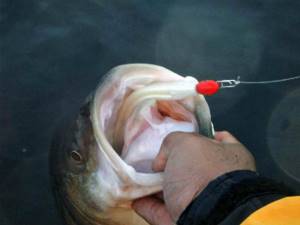
From the experience of experienced fishermen, we can say that the favorite food of marinka fish are crickets and small grasshoppers. Multi-colored hairy caterpillars, both live and artificial, can also be an excellent bait. Especially often, large marinka pecks at green or red caterpillars. But, perhaps, dropsy is considered a special delicacy for this fish - these are fat green larvae that can be found in the coastal mud under the bushes. However, if you don’t feel like digging in the mud, you can buy silicone analogues at a fishing store; in strong mountain currents, they are practically indistinguishable from the real thing.
What does Marinka bite on in different seasons?
Unlike carp or carp, Sharmai is less dependent on the change of season, preferring food of animal origin - worms, larvae, bloodworms, crustaceans, amphipods. At the same time, Marinka intensively feeds on insects at the time of spring emergence or berries and cereals (corn, oats, wheat) in the summer months. Universal attachments include:
- cricket and grasshopper;
- larvae of horsefly (dropsy), dragonfly (naiad), chafer (furrow);
- caddisfly, tubifex;
- caterpillars, especially light green ones;
- crayfish neck and shrimp;
- filamentous green algae;
- white earthworm (crawling).
In practice, trophy specimens are caught on slightly crushed large mulberries (mulberries) of white or dark color. You should be especially careful when choosing bait for mountain fishing for marinka, where dropsy, caterpillars, and crickets remain out of competition. If the reservoir is inhabited by the Illian or pike subspecies, you should actively use small bottom baitfish - gudgeon, loach, char or brush.
RESERVOIRS
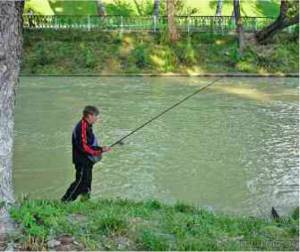
Since I live in Tashkent, first of all I’ll tell you about those city reservoirs where I most often catch marinka myself. If you look at the map of Tashkent, you can see that this ancient city is literally riddled with a whole network of canals and small ditches. And this is natural - in a dry and hot local climate, nothing will grow without watering. Almost all canals are of artificial origin, and the history of some of them goes back hundreds of years. They originate from mountain rivers, so the water in them is very cold and clean. In all these canals - from the largest to the smallest, reminiscent of a small stream - there is fish, and the main species is the common marinka.
You should start getting acquainted with marinka fishing from urban reservoirs for several reasons: firstly, it is close to home, secondly, you can always meet a local fisherman on the shore who will help if you have questions, thirdly, fishing in urban reservoirs is much easier and more productive than in mountain rivers and, fourthly, it is here, oddly enough, that the largest, trophy specimens of these fish are found.
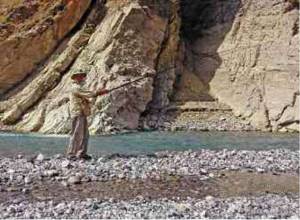
The main water artery of Tashkent is the Chirchik River, flowing along its southeastern outskirts. Full of water in winter, spring and autumn, in summer it becomes like just a big stream - too much water is spent on irrigation. Due to the summer shallowing, the water in the river warms up quite well, so it is mainly inhabited by fairly heat-loving fish - crucian carp, small carp, snakeheads and catfish. But the areas with the fastest currents are invariably occupied by marinkas, and it is in the relatively warm Chirchik that they often grow to trophy sizes. Above Tashkent and right up to its very sources, Chirchik becomes much deeper in water, acquires a mountainous character, and the marinka is the dominant fish species in it. Due to the presence of an abundant food supply, the Chirchik marinka is the most finicky - catching it requires knowledge of catchable places, good command of gear and skillful selection of baits. The best time for catching marinka in this river is from August to October, before the start of rains and the pre-winter rise of water.
The deepest of the artificial canals flowing through Tashkent and the region is Bozsu (translated as “ice water”). The canal fully lives up to its name - the water in it is icy even in the most extreme heat, because it’s not for nothing that it is the base reservoir for Tashkent walruses! Originating in the upper reaches of the same Chirchik, it is inhabited by large marinka, and even trout can be found in its upper reaches. The canal is deep and flows from its sources in a stone and concrete bed, so the best areas for fishing are in places where the channel widens and turns, as well as below the dams of small hydroelectric stations, of which there are about a dozen on the canal. The best period for fishing on this powerful channel is the period of low water, which happens from August to October, as well as in April, before the rapid melting of mountain snows.
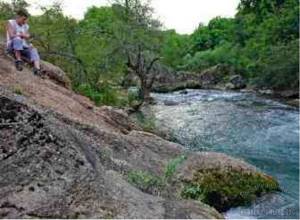
Bozsu also feeds other Tashkent canals, the most deep of which are Ankhor and Burjar. These canals flow almost along their entire length along natural channels (in some places, however, the embankments are reinforced with concrete) and over the hundreds of years of their existence they have sunk deep into the clayey soil. Their banks are very steep, covered with dense bushes and old trees, and in many areas are difficult to access. The water in these canals is much warmer than in Bozsu, so along with marinkas, they also contain other fish, for example, quite large carp. In Ankhora they catch fish mainly in spring and early summer, when marinka actively bites on baits of plant origin. They don’t overthink the choice of location, but catch them directly from the concrete embankments. On Burjar, almost any area where you can get to the water is catchable. There are not so many such places and they can be identified by dug steps on almost vertical steep banks and by bushes thinned by fishermen near the water, so that you can turn around there at least a little.
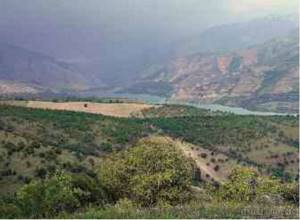
There are two more Tashkent canals that visiting fishermen should pay attention to: Karasu and Salar. These small channels have relatively warm water and are heavily overgrown with algae, in which marinkas like to stay. The Karasu Canal flows along its entire length in a natural, rather winding channel. Due to the easily eroded loamy banks, the water in the canal is almost always muddy (translated as “black water”), but this does not prevent the marinkas living there from growing to a respectable size. The very small Salar Canal flows almost through the city center. It differs from other urban reservoirs in having the warmest water and the highest density of fish (there are even crayfish!), although it can only be classified as clean only conditionally. It’s hard to believe, but it is in this channel, where the water is “knee-deep to a chicken,” that you most often come across kilogram marinkas, and along with these lovers of cold water, you can also catch a three-kilogram carp and an even more respectable somyanka. Another distinctive feature of this canal is that successful fishing in it is possible all year round.
Marinka constitutes the main fish population of Asian mountain rivers and lakes. A hundred kilometers from Tashkent, upstream of Chirchik, a dam was built, forming the largest mountain reservoir in Uzbekistan - Charvak. The places around this reservoir are very picturesque and are a favorite vacation spot for Tashkent residents. Fishermen have plenty to do here - more than a dozen large and small rivers flow into the reservoir, in which, in addition to the marinka, there are trout, osmans, char and other lovers of clean cold water. Although Marinka is a mountain fish, it does not like too cold water, so it concentrates mainly near the mouths of rivers and streams, and there is also quite a lot of it in the reservoir itself. You shouldn’t strive for the upper reaches of rivers for another reason - watershed ridges are also borders between neighboring states, so misunderstandings may arise with border guards. The best time for fishing in mountain reservoirs is in the spring before the rapid melting of snow (May) and the period of lowest water, which happens in August-September.
It is almost impossible to see marinka even in the clearest water of mountain rivers - the fish are perfectly camouflaged and do not show their activity in the form of splashes at the surface. But in some places, observing marinkas in their natural environment does not involve any problems - the fish there are not at all afraid of humans. These are mozars, places of worship of Muslim shrines. Usually these are ancient graves or mosques, next to which there are springs or small pools of water - houses, in which the Marinkas live. In one of the springs near the town of Nurata, located at the southern edge of the famous Kyzylkum desert, I watched hundreds of marinkas, which were so tame that they took bread crumbs directly from their hands. Catching fish in holy reservoirs is considered a great sin, therefore, fed by pilgrims and tourists, they grow there to a respectable size.
Marinka's food
The common marinka eats everything; it is an omnivorous aquatic inhabitant that can eat small minnows and loaches, but most of all it loves to feast on invertebrates: caddis and honeydew larvae, all kinds of beetles, and aerial insects.
Among aquatic vegetation, it prefers filamentous algae, aquatic grass, and detritus.
Despite such an abundant diet, the fish is not a fast-growing species; at the age of one year its size does not exceed 5–6 cm .
Marinka baits
The choice of bait depends on the specific time of year when fishing occurs:
- In spring, fish are not particularly picky in choosing their food supply. These could be crickets, all kinds of bugs, green peach cut into small pieces, melon. For information: it is better to select animal bait on the shore of the reservoir in which the hunt will take place. Bait is easy to find under rocks and among coastal vegetation.
- In summer, fish are readily caught using bait of plant origin, in particular bread crumbs, mulberries, cherries, and grapes. The fish reacts especially vividly to bright, medium-sized berries.
- In the fall , when the water in the reservoir is already cool and the predator instinct of the fish is activated, animal bait in the form of caddisfly, maggot, and small red worm becomes a priority.
- In winter, fishing is effective using bait of animal origin.
If fishing is carried out in large and small mountain rivers, where there is a strong current, invertebrate inhabitants and various insects living on the shore are used.
What does Marinka fish like?
Among the catchable baits for marinka are:
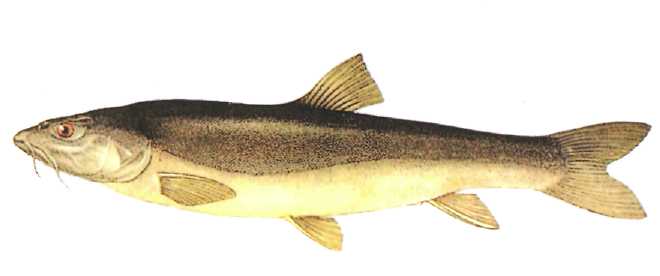
- Dropsy (green larva) can be found either in the mud or in coastal vegetation. Finding it, of course, is difficult, but such bait is stored well, especially in a wet cloth. This is a favorite delicacy of mountain fish. You can catch large fish with this bait. The dropsy stays on the hook quite well. You can purchase larvae both from the local population and in a specialized store, but here there will already be an artificial version of dropsy. When fishing in a strong current, there are no special differences, both natural and artificial dropsy perfectly attracts predators.
- Cricket . The only fish that are affected by crickets is the marinka; other aquatic inhabitants ignore them. The best time for collecting crickets is considered to be early morning, and the collection place is cultivated fields, dry banks among stones. For storage, it is advisable to use small boxes filled with grass. Often the redfish only reacts to crickets rather than to any other type of bait.
- Caterpillar . One of the usual types of food for such fish are hairy and colorful caterpillars. The bait collection area is bushes and small trees. For large specimens, green caterpillars are more suitable.
- Caddisfly , amphipod, red worm, honeydew. It is much easier to collect them, but you will no longer be catching large fish, but small fish. This kind of bait stays on the hook very poorly.

